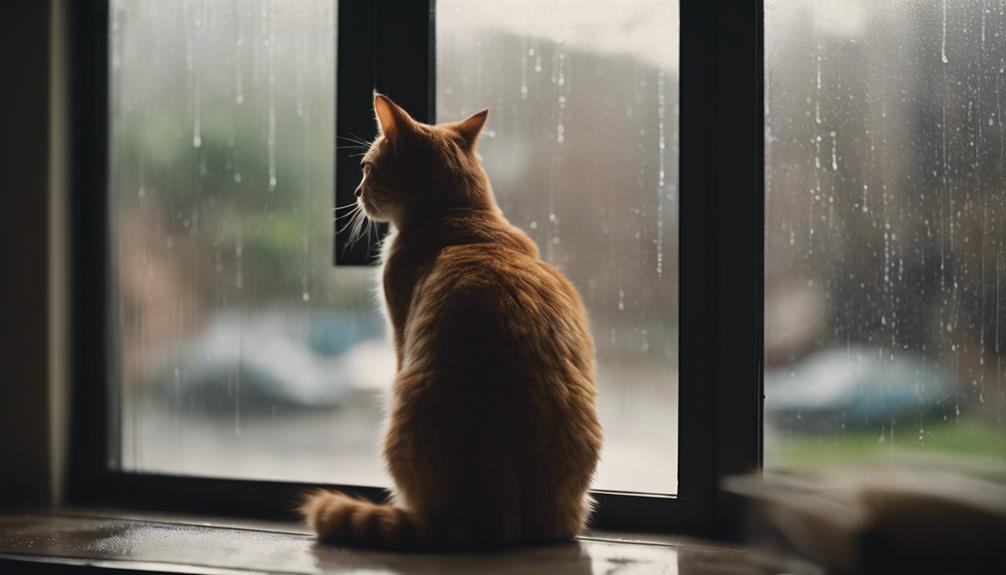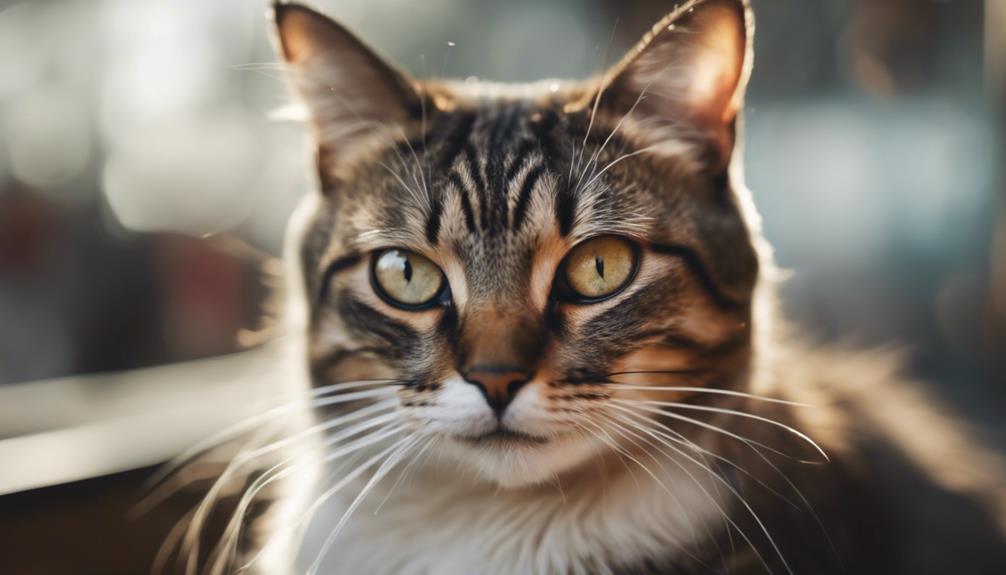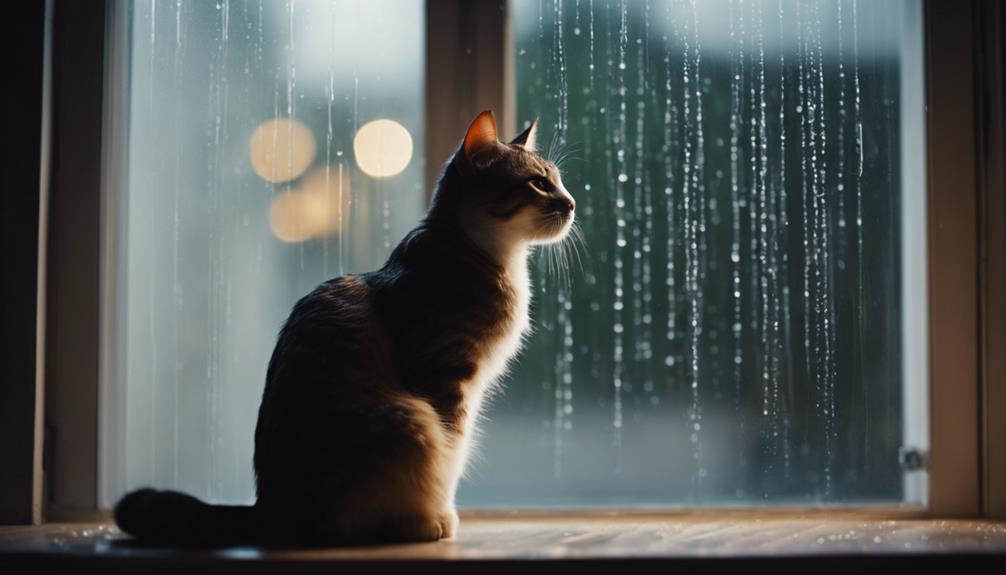Exploring the emotional realm of our feline companions often leads to intriguing discoveries about their well-being and how we can support them better.
When it comes to the question of whether cats cry, a feline behavior expert sheds light on this topic, offering valuable insights into understanding and addressing our cats' emotional states.
By unraveling the complexities of cat emotions and behaviors, we can navigate the subtle cues they provide and effectively respond to their needs.
This discussion provides a gateway to a deeper understanding of our cats' emotional world and offers practical guidance on how to help them navigate moments of distress.
Key Takeaways
- Cats exhibit emotions like sadness, indicating they can feel blue.
- Understanding cat behaviors can help address their emotional well-being.
- Seeking professional guidance can assist in managing cat emotions effectively.
- Building a strong bond with your cat can alleviate feelings of sadness or loneliness.
Signs of Cat Distress
When observing feline companions, recognizing subtle behavioral cues is crucial in identifying signs of distress in cats. Common indicators of cat distress include changes in litter box habits, excessive grooming, withdrawal from social interactions, decreased appetite, and increased vocalization.
Cats may also exhibit aggressive behavior, such as hissing or swatting, when feeling distressed. Paying attention to body language, such as flattened ears, dilated pupils, or a tense body posture, can provide valuable insights into a cat's emotional state.
It is essential to address these signs promptly to alleviate any underlying issues causing distress. Seeking guidance from a veterinarian or animal behaviorist can assist in developing a suitable plan to improve the well-being of a distressed feline companion.
Understanding Cat Communication
Recognizing subtle cues in a cat's behavior is essential for understanding how they communicate their emotions and needs. Cats use a combination of body language, vocalizations, and even facial expressions to convey their feelings.
For instance, a cat with flattened ears and dilated pupils may be feeling fearful or defensive, while a cat purring and rubbing against you is likely expressing contentment. Meowing, hissing, and chirping are vocalizations that cats use to communicate with humans and other animals.
Additionally, a cat's tail position and movement can indicate whether they are feeling relaxed, agitated, or playful. By paying attention to these communication signals, cat owners can better understand their feline companions and strengthen their bond.
Managing Cat Anxiety

Understanding effective strategies to alleviate cat anxiety is crucial for promoting your feline companion's emotional well-being. Cat anxiety can manifest in various ways, such as excessive grooming, hiding, or aggression.
To help your cat feel more secure, create a safe and comfortable environment. Providing vertical spaces, hiding spots, and interactive toys can help reduce stress and anxiety. Establishing a routine for feeding, playtime, and affection can also offer predictability, which is comforting for cats.
Additionally, pheromone diffusers or calming collars may aid in relaxation. If anxiety persists, consult with a veterinarian or feline behaviorist for further guidance. By addressing your cat's anxiety proactively, you can enhance their overall quality of life and strengthen your bond.
Behavioral Cues in Cats
To better interpret and respond to your cat's emotional state, it is essential to observe and understand the subtle behavioral cues they exhibit. Cats communicate through body language, vocalizations, and actions. Dilated pupils, flattened ears, and a swishing tail can indicate fear or aggression.
Purring, rubbing against you, and kneading suggest contentment and affection. Excessive grooming, hiding, or loss of appetite may signal stress or illness. Paying attention to changes in your cat's routine, interactions, and habits can provide valuable insights into their well-being.
Cat Emotions and Expressions

Cats often display a wide range of emotions through their subtle facial expressions and body language. While cats are known for their independent nature, they can still convey feelings of contentment, affection, fear, and even sadness through various cues.
A cat expressing happiness may exhibit relaxed body posture, purring, and slow blinking. On the other hand, signs of fear or stress can include flattened ears, dilated pupils, and a twitching tail. Understanding these emotional signals is crucial for providing appropriate care and addressing any underlying issues that may be causing distress.
Identifying Cat Loneliness
Loneliness in felines can manifest through subtle behavioral changes and cues that pet owners should be attentive to. Cats experiencing loneliness may exhibit increased vocalization, excessive grooming, or changes in eating habits. They might seek more attention from their owners, follow them around the house more than usual, or display a lack of interest in playing.
Additionally, lonely cats may spend more time sleeping or hiding away in secluded spots. It is important for pet owners to recognize these signs and provide their feline companions with companionship, interactive toys, and environmental enrichment to alleviate feelings of loneliness. Creating a stimulating and engaging environment can help prevent or reduce loneliness in cats, promoting their overall well-being.
Health Factors in Cat Behavior

Health factors play a significant role in influencing cat behavior, impacting both their physical and emotional well-being. Behavioral issues in cats can sometimes be indicative of underlying health problems, emphasizing the importance of regular veterinary check-ups to monitor their overall well-being.
Stress and anxiety, common in cats, can have adverse effects on their physical health, highlighting the need for a healthy diet and ample exercise to prevent behavioral issues. Cats suffering from health issues may exhibit changes in behavior, such as increased aggression or decreased activity levels.
Recognizing these signs and addressing the root cause through proper medical attention and care is crucial in maintaining a happy and healthy feline companion.
Professional Assistance for Cats
Recognizing the signs of behavioral issues in felines and understanding when professional assistance is necessary can significantly benefit the well-being of your cat. When your cat's behavior deviates from their usual patterns, such as sudden aggression, excessive meowing, or withdrawal, seeking help from a behaviorist or veterinarian is advisable.
These professionals can conduct a thorough evaluation to determine the underlying causes of your cat's behavior problems. In cases where medication is needed to manage severe anxiety or other issues, a veterinarian can provide appropriate treatment. Training classes or therapy sessions may also be recommended to address behavioral concerns effectively.
Caring for a Sad Cat

When a cat displays signs of sadness, it is crucial for pet owners to provide attentive and compassionate care to support their emotional well-being. Understanding your cat's behavior and emotions is key to offering the right kind of support. Here are some ways to care for a sad cat:
| Caring for a Sad Cat | ||
|---|---|---|
| 1. Comforting Environment | 2. Engaging Playtime | 3. Healthy Diet |
| Ensure a safe and quiet space for your cat to retreat to. | Stimulate your cat with interactive toys and activities. | Provide nutritious food and fresh water daily. |
| 4. Regular Affection | 5. Veterinary Check-up | |
| Offer gentle petting and cuddling to reassure your cat. | Schedule regular check-ups to monitor your cat's health. |
Conclusion
In conclusion, unraveling the mysteries of feline emotions and behaviors is essential for cat owners to provide optimal care and support. By recognizing signs of distress, understanding cat communication, and addressing anxiety and loneliness, we can better attend to our cats' emotional well-being.
Remember, just as humans express their feelings, cats too may exhibit signs of sadness or distress. By being attuned to their needs and seeking professional help when necessary, we can ensure our feline companions lead happy and healthy lives.




